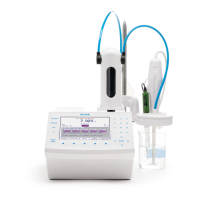Apparatus required for automatic titration include:
• An automatic titrator, equipped with a burette
• A beaker
• An electronic stirring system, either a propeller stirrer or a magnetic stir bar and stir plate
• Volumetric pipettes for the precise addition of samples
• Standard titrant solutions of known concentration
• An electrode system that can be used to determine the endpoint of the titration
A typical automatic titration consists of the following steps:
1. Set up the automatic titrator according to the manufacturer’s instructions
2. A volumetric pipette is typically used to add a known volume of sample to the beaker
3. Submerge the propeller stirrer or add the stir bar to the beaker, and turn on
4. Start the titration, the titrator will automatically stop at the endpoint and determine the concentration of the analyte
4. TITRATION RESULTS
4.1. ACCURACY
The factors most critical to achieving accurate results with the HI932 titration systems are the concentration of the sample, size of the
sample and having an optimized set of method parameters.
4.2. REPEATABILITY
Repeatability, or the agreement between replicate determinations, is expressed quantitatively as the relative standard deviation
(RSD).
4.3. SOURCES OF ERROR
One of the advantages of volumetric analysis is excellent accuracy and precision. The sources of error can be grouped into sampling,
titrant and standards, chemical reactions, endpoint determination and calculations.
4.3.1. SAMPLING ERRORS
• Selection of a non-homogeneous or non-representative sample
• Sample changed or was contaminated during collection, storage or transfers
• Poor technique when transferring sample to beaker or flask
• Errors in the balance, calibrate and check balance regularly
4.3.2. ERRORS WITH TITRANT AND STANDARD
4.3.2.1. PREPARATION ERRORS
Incorrect preparation due to:
• Poor technique in weighing the salt or when transferring to volumetric glassware
• Low-purity of salts or water used to make titrant and standard
• Dirty or wet glassware
• Improper storage of titrant or standard which allows water gain, evaporation or deterioration
• Failure to standardize frequently to adjust for change in titrant
• Failure to flush titrator tubing with a volume of titrant before standardizing
• Volume errors from pipettes and volumetric flasks, grade A glassware is required
• Balance errors when weighing out salts, calibrate and check balance regularly

